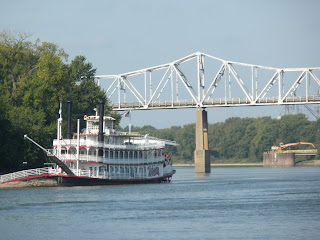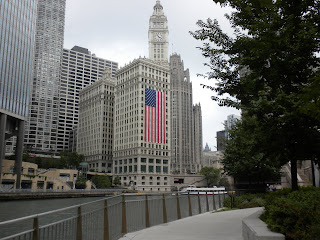September 10: After leaving Chicago, we entered the Chicago Sanitary Canal and then the Illinois River. The Illinois River connects Chicago to the Mississippi River. A series of 7 locks and dams enable vessels to traverse the Illinois. The traffic and locks on this section of the waterway are very different from the ones that we have experienced in Canada and the Erie Canal. For a start, these locks are operated by the Army Core of Engineers and are much longer and wider-single chamber ones are 110 feet wide and 600 feet long. Double chamber locks are even larger at 110 feet by 1,200 feet. The increased size is necessary to accommodate the principal travelers through these locks: commercial tows and their barges. Commercial tows have right of way over us mere "recreational" boaters.
Now, we need to pay attention to river currents and the depth (pool) of the river which can vary substantially depending on how much rain has fallen. After passing through a permanent electric barrier which was installed to prevent the invasion of foreign fish species (Asian Carp primarily) into Lake Michigan, we entered our first lock.
Entering the Lockport Lock. Fortunately, we did not have much of a wait. This lock dropped us down 40 feet and took half an hour.
A heron sitting on the lock gate.
The Admiral at the helm..
Passing one of the tows. Rather a nerve racking experience! The tows cannot stop or turn easily, so we need to mind our Ps&Qs and give them a wide berth.
We arrived in Joliet late in the afternoon and tied up to the wall in the Joliet Bicentennial Park. As the Park is not in the greatest section of town, we elected to have supper on the boat.
We arrived in Joliet late in the afternoon and tied up to the wall in the Joliet Bicentennial Park. As the Park is not in the greatest section of town, we elected to have supper on the boat.
September 11: We have a long journey today so we were up and en route as soon as the sun was up. We had raised our mast the night before so we are back up to 19.5 ft. The first bridge we encountered was 16.5 feet so we had to wait for it to be opened. Then we were onto the Brandon Rock Lock which is a 34 ft drop but as there was no commercial traffic waiting to go through, we were able to breeze right in.
This is part two of the barge with its tow!
We had to tie up to these round concrete mooring platforms to wait our turn to go through the lock. This is fellow Looper, Last Chance, securing to the platform. It is rather a tricky maneuver, the platforms are very rough and there is considerable current just before the Lock. We have been traveling with Martin and Allison on Last Chance since we left Chicago and have enjoyed their company. We finally made it into Ottawa, tired and very glad to reach the town dock.
Ottawa is a well kept, quaint town. This is the city hall.
Mural on the side of one of the town's restaurants.
More murals celebrating the 50s and 60s.
Statues of Abraham Lincoln and Senator Douglas. Ottawa was the site of the first debate between the two for the US Senate. Douglas went on to win reelection to the Senate but lost the Presidential race two years later to Lincoln.
Old paddle boat converted into a restaurant.
We spent the night tied up to an abandoned lock wall in Henry Harbor. This lock was the first lock established on the Illinois River in 1872. It was last used in 1927.
September 14: Today we are making for the National Marina in Peoria. Since leaving Chicago, we have noticed a high pitched whining noise when we operate the boat at low speed and switch gears. Yesterday, it was more pronounced and we heard it at higher speeds so we decided that we should be hauled and have investigate the cause.
We arrived at the Marina at 10:30 and after plowing through some muddy, shallow water (3.5 ft in places-and we draw 4.5 ft!!) we maneuvered into the travel lift and the boat was hauled out of the water. Close examination showed that it was extremely difficult to rotate the propeller. Our fears regarding failed cutlass bearings were confirmed.
The two legged crew were fortunate to have a ladder to descend from the boat but we had to improvise a system to lower his majesty down for his constitutionals. He looks happy with the arrangement!
Perhaps not happy...just resigned!
September 15: Today the spare parts arrived but unfortunately one of the cutlass bearings is not exactly the same size as the one that was removed yesterday..so we have to wait for a new one to be ordered. The crew here have been great. As the marina is located in an isolated area, the owner drove us into town so that we could buy some groceries and have a meal.
September 16: The new part arrived today. The shaft, prop and rudder were all reattached and the alignment was checked. We were lowered back into the water and motored into one of their slips. The alignment was rechecked in the water, adjustments made and the job was finally completed.
We will spend the night here as it is too late to travel further and head out early in the morning. We are relieved that the job is done even if it did cost a few bucks.










































